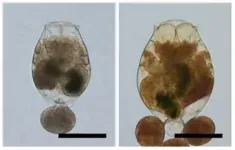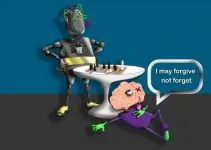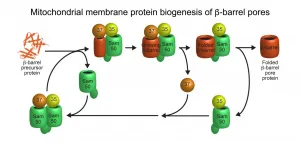The end of domestic wine in 17th century Japan
September 1632 document likely shows the order for the last batch of Japanese wine in the Edo period
2021-01-15
(Press-News.org) Researchers from Kumamoto University (Japan) have found an Edo period document that clearly indicates the Hosokawa clan, rulers of the Kokura Domain (modern-day Fukuoka Prefecture), completely stopped producing wine in 1632, the year before the shogunate ordered them to move to the Higo Domain (now Kumamoto Prefecture). The researchers believe that the discontinuation of wine production was directly related to this move and because it was considered to be a drink of a religion that was harshly suppressed in Japan at that time, Christianity.
Previous analysis of historical documents revealed that the lord of the Hosokawa clan, Tadatoshi Hosokawa, ordered wine production from 1627 to 1630 for medicinal use. His vassals, who were experienced in various western customs and technologies#mdash;from foods to watches, used black soybeans and wild grapes in their brewing process. Those documents are the earliest known proof of Japanese wine production.
Until now, no historical records regarding wine production after 1631 had been found. Previously, researchers understood there to be a four-year period of Japanese winemaking. Production was thought to be halted because it was a stereotypically Christian drink and making it could have been a dangerous prospect due to the shogunate's strict prohibition of Christianity during the Edo period.
The new document, from September 1632, was found in the Eisei Bunko Library's Hosokawa clan repository and is a clear order for one more batch of wine. A note written on the document by the magistrate dated October 3rd, 1632 (No. 10.7.13) is as follows.
[Original Japanese]
一、ぶだう酒御作せ可被成候間、がらミをとらセ上田太郎右衛門所へ遣可申旨、則太郎右衛門を以被仰出候事、
[Rough translation]
Taroemon Ueda has personally informed the magistrate's office that he received an order from the lord to have wild grapes collected and brought to him for wine production.
Taroemon Ueda was a Hosokawa clan vassal who had training in Western techniques and had been making wine since 1627. Later in the document, the magistrate wrote another note.
[Original Japanese]
がらミ、太郎右衛門へ渡候、
[Rough translation]
Wild grapes were provided to Taroemon.
The document does not say when wine production was completed. However, earlier documents revealed that Taroemon usually took about 10 days to finish making wine, so researchers believe that this batch was probably finished by mid-October 1632 at the latest. On January 18th of the following year, the shogunate ordered the Hosokawa clan to move from the Kokura Domain, where all of the wine was made, to the Higo Domain.
Historical documents related to wine production in the Higo domain have not been found. The researchers believe that the Hosokawa clan stopped making wine as a direct result of their move to a new domain and because wine was heavily associated with Christianity.
Soon after the move to the Higo Domain, the Hosokawa clan faced off with Western-influenced rebels. They were on the front lines of Christian oppression which led to the suppression of the "Shimabara-Amakusa Revolt" in 1637. The tightening prohibition of Christianity, outbreaks of Christian revolts, and the suppression of the revolt brought the history of Japanese domestic wine in the 17th century to a close.
INFORMATION:
Eisei Bunko Research Center
The Eisei Bunko Research Center was established in FY2009 to retain and care for ancestral works of art, literature, and other historical materials of the Hosokawa family, the once daimyo of Kumamoto. In 1964, several pieces from the Hosokawa Mansion in Kumamoto City's Kitaoka Nature Park were entrusted to the Kumamoto University Library. Currently, the collection contains over 100,000 historical documents that the university uses for education and research.
[Attachments] See images for this press release:

ELSE PRESS RELEASES FROM THIS DATE:
2021-01-15
Divergences between scientific and Indigenous and Local Knowledge can provide a better understanding of why local pastoralists may be willing, or not, to participate in conservation initiatives for carnivores, a study from University of Helsinki suggests.
Carnivore conservation has historically been based primarily on scientific knowledge using a wide range of sampling methods, such as camera trapping and track surveys. However, the estimates of these common ecological sampling methods can be quite uncertain and can depend on accessibility and geology, which is the case of many remote areas, such as Sibiloi National Park in Northern Kenya. For this reason, the inclusion of local communities that share ...
2021-01-15
A research team led by scientists at the RIKEN Nishina Center for Accelerator-Based Science (RNC) has successfully created larger-than-usual strains of zooplankton -- which are used in fish nurseries -- by creating mutations with a heavy ion beam. The new strains of zooplankton could contribute to improving the survival rate and optimizing the growth of juvenile fish in aquaculture.
Economically important fish species, such as bluefin tuna, yellowtail, flatfish and groupers, are fed live bait until they are large enough to be fed with artificial foods. ...
2021-01-15
Any building project requires the formulation of a series of initial plans prior to starting construction to serve as a basis and guide for the whole process. A similar procedure is followed in software development, with the inclusion of a specific step known as modelling. "The process is equivalent to the production of a set of plans for a building before its construction," explained Universitat Oberta de Catalunya (UOC) Faculty of Computer Science, Multimedia and Telecommunications professor and member of the SOM Research Lab research group -from the Internet Interdisciplinary Institute (IN3)-, Robert Clarisó.
Engineers use modelling to describe ...
2021-01-15
In the last decades, Artificial Intelligence has shown to be very good at achieving exceptional goals in several fields. Chess is one of them: in 1996, for the first time, the computer Deep Blue beat a human player, chess champion Garry Kasparov. A new piece of research shows now that the brain strategy for storing memories may lead to imperfect memories, but in turn, allows it to store more memories, and with less hassle than AI. The new study, carried out by SISSA scientists in collaboration with Kavli Institute for Systems Neuroscience & Centre for Neural Computation, Trondheim, Norway, has just been published in Physical Review Letters.
Neural networks, real or artificial, learn by tweaking the connections ...
2021-01-15
An innovative new study is set to examine if changing our mealtimes to earlier or later in the day could reduce the risk of developing Type 2 diabetes.
Led by Dr Denise Robertson, Professor Jonathan Johnston and post graduate researcher Shantel Lynch from the University of Surrey, the study, outlined in the journal Nutrition Bulletin, will investigate if changing the time we eat during the day could reduce risk factors such as obesity and cholesterol levels that are typically associated with the development of Type 2 diabetes. The team of researchers will also for the first time investigate, via a series of interviews with participants and their friends and family, the impact of such changes on home life, work/social commitments and whether co-habitants of those who make such ...
2021-01-15
Having genitals of a certain shape and size gives male flies a major reproductive advantage, new research shows.
University of Exeter scientists examined the reproductive success of male Drosophila simulans flies both alone with a female and in various states of competition with other males.
Certain genital shapes were consistently better in terms of number of offspring sired.
However - surprisingly, given how fast genital form evolves - the selection documented was rather weak.
"Male genitals generally, and in Drosophila specifically, evolve very quickly, so we were really surprised to find this weak selection," said Professor David Hosken, of the University of Exeter.
"Selection is the major mechanism of evolution and hence where we see rapid evolution, ...
2021-01-15
Mitochondria are vital for the human body as cellular powerhouses: They possess more than 1,000 different proteins, required for many central metabolic pathways. Disfunction of these lead to severe diseases, especially of the nervous system and the heart. In order to transport proteins and metabolites, mitochondria contain a special group of so-called beta-barrel membrane proteins, which form transport pores in the outer mitochondrial membrane. So far, scientists have not been able to explain the operating mode of the sorting and assembly machinery (SAM) for the biogenesis of these beta-barrel proteins. A team led by Prof. Dr. Toshiya Endo from Kyoto University/Japan, Prof. Dr. Nils Wiedemann and ...
2021-01-15
Guangzhou, January 15, 2021: New journal BIO Integration (BIOI) publishes its fourth issue, volume 1, issue 4. BIOI is a peer-reviewed, open access, international journal, which is dedicated to spreading multidisciplinary views driving the advancement of modern medicine. Aimed at bridging the gap between the laboratory, clinic, and biotechnology industries, it will offer a cross-disciplinary platform devoted to communicating advances in the biomedical research field and offering insights into different areas of life science, in order to encourage cooperation and exchange among scientists, clinical researchers, and health care providers.
The issue contains an original article, three review ...
2021-01-15
A clinical trial involving COVID-19 patients hospitalized at UT Health San Antonio and University Health, among roughly 100 sites globally, found that a combination of the drugs baricitinib and remdesivir reduced time to recovery, according to results published Dec. 11 in the New England Journal of Medicine. Six researchers from UT Health San Antonio and University Health are coauthors of the publication because of the San Antonio site's sizable patient enrollment in the trial.
The Adaptive COVID-19 Treatment Trial 2 (ACTT-2), which compared the combination therapy versus remdesivir paired with an inactive placebo in hospitalized COVID-19 patients, was supported by the National Institute of Allergy and Infectious Diseases (NIAID), ...
2021-01-15
Certain snakes have evolved a unique genetic trick to avoid being eaten by venomous snakes, according to University of Queensland research.
Associate Professor Bryan Fry from UQ's Toxin Evolution Lab said the technique worked in a manner similar to the way two sides of a magnet repel each other.
"The target of snake venom neurotoxins is a strongly negatively charged nerve receptor," Dr Fry said.
"This has caused neurotoxins to evolve with positively charged surfaces, thereby guiding them to the neurological target to produce paralysis.
"But some snakes have evolved to replace a negatively charged amino acid on their receptor with a positively charged one, meaning the neurotoxin is repelled.
"It's an inventive genetic mutation and it's been completely missed until now.
"We've ...
LAST 30 PRESS RELEASES:
[Press-News.org] The end of domestic wine in 17th century Japan
September 1632 document likely shows the order for the last batch of Japanese wine in the Edo period





